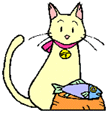Vol. 1, No. 43
Table of Contents
Assist Feeding – Calories and Bioavailability
Feline Nutrition – How much is enough?
Pro-Active Cat Care – When To Say NO!
Feline Obesity – Comfort Feeding
Kitty Potpourri – Why is Kitty’s “Motor” Running?, Part II
Assist Feeding – Calories and Bioavailability
by Kathy Fatheree
I really like Garry’s Feline Nutrition article this week titled “How much is enough?” because this is an issue I really struggled with when I syringe fed my cat Bubba and (years earlier) his sister Sissy. Just like most vets do, it was suggested to me that I get one can of food in per day. Both Bubba and Sissy were large cats and I should have been feeding them more. I had no clue about calories when I assist fed Sissy and thankgoodness I was a little smarter when I assist fed Bubba. Garry really simplifies things and gives you a great ballpark figure to work with so be sure to read his article below.
Getting enough calories into a cat that doesn’t want to eat is a difficult and stressful thing. When you know how many calories you need to feed, that too can be a stressful thing when you are not meeting your goal. If you miss the goal the majority of days, your cat will maintain his or her weight for several weeks, but then, and with great steadiness, your kitty will start to lose weight before your very eyes. It’s hard to make up lost calories, so it’s of the utmost importance to diligently feed your fur baby the proper amount of calories each and every day.
CAUTION: This is not the time for a fat cat to lose weight because a sick cat losing weight in this manner is losing muscle… not fat. Don’t let anyone tell you “oh kitty needed to lose weight anyway.”
Knowing how much to feed your can also be a wonderful thing when you meet your daily goal. You will feel relieved that you are getting the proper calories into your kitty and your kitty will feel better, too. Getting the proper calories and nutrition into your kitty will enable your kitty’s body to heal the best that it can heal. Good nutrition can overcome many obstacles.
The quality of food plays a tremendous role in healing, too. If you are having to assist feed your cat, it is not the time to try to save money on food. Yes, quality food is more expensive, but don’t waste your time with the cheap stuff… you’ll just be throwing your money away and not doing your cat any favors. The food must be quality because if the food is overly processed or full of by-product meals, your kitty will not be able to utilize the vitamins and minerals that are in the over processed food. There’s a word for this and it’s called “bioavailability” . it means that the nutrients are in a form that the body can access and utilize for the nourishment of the body. Work closely with your vet to find a quality food. and do your own homework, too, and little by little you will become educated about quality foods. Start off by learning the basics and don’t expect to become an expert in just few weeks. Consistently read about feline nutrition, ask many different people many different questions about feline nutrition, throw in your common sense and throw out the things that people tell you that don’t seem to add up. Learning about feline nutrition takes quite a bit of time, but it’s well worth it.
Feline Nutrition – How much is enough?
by Garry White
We spend a great deal of time and effort these days analyzing cat foods. And we should; the information is readily available, and there’s no question that proper nutrition helps to assure a longer, healthier life. So we pay close attention to things like: Ash content, phosphorous, sodium, magnesium, manganese, and a host of other nutrients. We’ve learned that these percentages can (and do!) vary greatly from one manufacturer to another. But here is another question we need to be asking, and it is, perhaps, more important than any other: What is the energy value of this food? Translated, that means calories.
We all know that cats who go for extended periods of time without proper nutrition suffer the risk of Hepatic Lipidosis (fatty liver disease), which is often fatal. (Ask one of our readers, Petie Brigham, how long it takes this fun disease to settle in, and how hard it is to recover.)
So let’s analyze the term proper nutrition and change the order of things a little. While it’s certainly important that we control the intake of various nutrients, it’s equally important (if not more so) that we keep a close eye on the energy value of their foods. Whether a cat is perfectly healthy, or ailing, this requirement doesn’t change, and in fact is even more important with sick kitties. Sick or healthy, when the energy intake falls below what is required to sustain, their immune system weakens, which inhibits the body’s natural ability to ward off bacterial invasions. So we need to be cognizant of this critical fact: It’s true that too much or too little of any other nutrient will have a long-term negative effect, but too little energy intake puts them at serious risk right now, so we have to move energy value to the forefront of our quest for the perfect food.
Oh, great.but what are the daily requirements for energy intake? Ah, I’m glad you asked. First of all, the value is measured in calories. I queried three vets and got wishy-washy answers, meaning they didn’t know. AAFCO probably publishes this somewhere, but I couldn’t find it. So I went to several manufacturers (commercial and holistic), and consistently the number was (about) 27.5 calories per pound of cat-weight, per day: Thus, if Fluffy weighs ten pounds, she needs about 275 calories every single day. Far as I can tell, these numbers apply to most cats, other than tiny kittens.
Where do you find the calorie content of a given food? Some manufacturers put it on the label, but most do not. Which means you have to call them and ask for a Nutrient Reference Chart for this food (actually, you can just ask for the calorie content, but I want ya’ll to get familiar with these charts.they tell us every ingredient, every nutrient, and this knowledge can be a lifesaver!). Shown below is a cutout from a typical Nutrient Reference Chart.
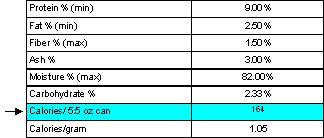
So that’s the scoop for this week. Start thinking energy value and calories. For those struggling to manage a suitable diet for a sick kitty, it’s most important that you, in particular, pay close heed to this. Certain ailments (including obesity) require a low calorie diet, but that does not change what’s required to keep the immune system up to par. If you’re in this arena, express these concerns to your vet, and remember: A diet that helps the ailment, but robs the kitty of adequate energy, will lead to the same bottom line.disaster!
ProActive Cat Care – When To Say NO!
by Garry White
Challenging a vet’s advice isn’t something we should take lightly, but there are times when it’s the right thing to do. That’s quite a statement, isn’t it? I mean, I’m not a trained professional, so how do I qualify such a position? Well, I think most of would agree that some vets (certainly not all) tend to make snap decisions without regard to the whole situation. True, I’m not a vet; but the story that’s about to unfold should serve to emphasize what I’ve said all along.that we need to be in control of everything that happens to our kitties, including vet care and health issues. But you be the judge.
Background: I discovered recently that Clark’s eating habits had changed. A heavy eater normally, he had taken to “nibbling”, and a closer look told me why: He was chewing on one side only, and he seemed to have lost a little weight. A peek under the gums said “bad tooth”, but I’m not a pro. Enter our house-call vet, the good Dr. Dimmick, who confirmed it; Clark had an abscessed tooth. Being a house-call vet only, Doc has no choice but to recommend nearby clinics for clinical work. So we made an appointment with a reputable shop that specializes in feline dental, and I took Clark there on a Tuesday. Oh yes, oh yes.that tooth is abscessed and needs to come out immediately.
Alarm #1 began to ring in my head as I listened to all the horrors that could happen from a bad tooth (these I recognized as scare tactics). But I listened quietly to New Doc’s agenda of things that had to be done right away. Blood work, first of all. This probably wasn’t really necessary, since the boy has NO indications of any other problems. But Clark’s not a youngster, so I go along with it; it can’t hurt to know that everything else is okay, and if something were amiss, it could alter the surgery procedures. Nonetheless, recommending costly, invasive tests that may not be needed became
Alarm #2. Onward: We discuss which induction agent to use for the anesthesia, and sure enough, New Doc recommends the scariest one (proposol, propofol.don’t trust my spelling), which can cause them to stop breathing for a short time, if administered too quickly; not a real concern for a younger cat, but Clark isn’t a younger cat, and this was
Alarm #3. But we work this one out: New Doc assures me (with a placating grin) that we can use something else if I want; I’m being mollified now, and this is
Alarm #4. Anyway, New Doc decides the tooth will come out the following Tuesday.one week. Kinda sudden, I thought, because pre-treatment antibiotics are a must before yanking an abscessed tooth, and that doesn’t leave much time for the drugs to take effect. This one was
Alarm #5, but I stay in the race, based on New Doc’s assurances.
Feline Obesity – Comfort Feeding
by Kathy Fatheree
Let me ask you a very personal question. How is your weight? Are you a little overweight? Have a few pounds to lose? And so does your kitty? Hum.
I personally really like to eat and I use food to comfort me more than I use it for the nourishment of my body. I KNOW! SHAME ON ME! I tell ya. I really try to work on this. and I’m getting a little better at it, but it takes time. lots of time!
I just wonder how many of us feed our cats “a little extra” to make ourselves happy rather than to really make kitty happy? Kitty probably sees how the feeding session makes us happy and THAT is what makes kitty the happiest! NOT the extra food! When kitty is begging for food, I really think that it’s mainly out of habit and for the enjoyment of getting some extra attention than it is because kitty is starving!
I used to have a habit that as soon as I walked in the door from work, I would feed my kitties thinking that they must be absolutely starving with me being gone all day. This set up the scenario that as soon as I walked in the door, my kitties were at my feet begging for their dinner! Forget the formal “Hello’s and how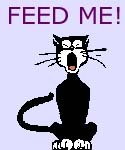 was your day?” . it was “Where’s the food Mom?!”I finally put an end to that and now when I come home from work, I take my time to pet each kitty just for a minute. change into my sweats. briefly look at the mail. and then casually ask my fur balls. “Are ya hungry?” To my initial amazement, they do just fine with this routine! This gives them time to calm down from the excitement of me returning home and they don’t wolf down their food!
was your day?” . it was “Where’s the food Mom?!”I finally put an end to that and now when I come home from work, I take my time to pet each kitty just for a minute. change into my sweats. briefly look at the mail. and then casually ask my fur balls. “Are ya hungry?” To my initial amazement, they do just fine with this routine! This gives them time to calm down from the excitement of me returning home and they don’t wolf down their food!
Many of the routines surrounding feeding time are those that we humans have created ourselves. If your kitty is begging for food when you know that she cannot be hungry, start substituting petting, playing, combing or other personal attention tactics rather than feeding your kitty extra food. At first, he or she many not understand why you’re not jumping up to supply the food, but over time, your kitty will start to seek your attention rather than the food bowl.
Tip of the Day: If you are feeding your cat a low-fat, low calorie food, and your cat is yowling and begging like there is no tomorrow, your cat may be missing essential nutrients and craving food no matter how much he or she eats! I fed Bubba a well-known, popular diet food for years and he drove me absolutely crazy with his yowling! I then read that a certain amount of fat is needed in the food to help the cat feel satisfied AND to enable him or her to absorb nutrients. Once I started meal-feeding Bubba regular food instead of diet food, the yowling stopped AND he lost weight!
Kitty Potpourri – Why is Kitty’s “Motor” Running?, Part II
by Dan Malenski
Last week, we explained the popular theories regarding how our feline companions produce their famous purring sounds and its characteristics. We also discussed studies that had shown that a cat’s purring is a part of the healing process for injuries. I will say no more about last week’s article, as I am getting that stern look from Melissa, prodding me to move on. This week, we will focus on how cat’s purring affects us, and a company’s effort to “bottle” that sound and why. The information for this week’s article was gleaned from an article written by Jackie Johnson of CatNews.com®.
The purring of a cat may affect their human companions in various ways. For example, the purring of cat 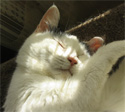 helps us recover from a stressful day, and even when the source of the stress remains, it helps us in dealing with it. Scientific evidence exists that the sound of purring lowers blood pressure in us, which explains why some cats serve as therapy cats in nursing and convalescent homes.
helps us recover from a stressful day, and even when the source of the stress remains, it helps us in dealing with it. Scientific evidence exists that the sound of purring lowers blood pressure in us, which explains why some cats serve as therapy cats in nursing and convalescent homes.
Eventually it was bound to happen in our day and age, that is, someone would get the idea of “bottling” and selling the sound of a purring cat to those interested in the stress-reducing properties of a cat’s purring but cannot live with them due to allergies and various other reasons. Well, that is exactly what happened one day when entomologist David Wustner from Northern California came up with the idea. His inspiration was his Siamese cat, Zena, sitting on his chest and purring up a storm! Thus, he formed a company named SDR enterprises dedicated to the task of capturing the sound of a cat purring and recording it onto CD media.
The task of recording a cat’s purring onto a CD is easier said than done as David learned when he encountered difficulty locating a cat-friendly studio. After he 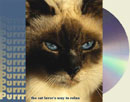 ultimately located one, the task of convincing a cat to purr in an unfamiliar place proved formidable. In addition, the cat would have to purr in the right direction and not want to bat the microphone around on the floor! He was ultimately successful after six weeks and five studio sessions, which led to the birth of a CD named “Purrr: The Cat Lover’s Way to Relax“, with his cat Zena as the recording artist.
ultimately located one, the task of convincing a cat to purr in an unfamiliar place proved formidable. In addition, the cat would have to purr in the right direction and not want to bat the microphone around on the floor! He was ultimately successful after six weeks and five studio sessions, which led to the birth of a CD named “Purrr: The Cat Lover’s Way to Relax“, with his cat Zena as the recording artist.
The CD has three tracks on it that produce a total of a little more than an hour of purring, and may be purchased David’s website (www.CatPurring.com), eBay, and through advertisements in Cat Fancy magazine. Melissa is nodding her head to insure that I remind everyone one that this article is not to be construed as an endorsement of the product, but merely to report its existence. Amanda chimed in that it cannot come close to the real thing, and I don’t think that anyone will disagree with her, but to some, it may be better than nothing at all!
The website named in the previous paragraph does contain a sample that you may download to your computer and listen too. However, it sounds a bit too raspy too me when I compare it to the purring champion (in my mind at least) of all time, and that is my Angel Mitzzi, who would purr nearly constantly and with the volume always on high. My Mitzzi (pictured in this paragraph) was keeping me company many years ago, 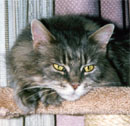 as she always did, while I was working a computer problem at about 3:00 A.M. with a group of engineers in Atlanta. The volume of her purring was so loud that it carried on the telephone to one of the engineers who inquired about the sound he was hearing. I responded by saying that the purring must be coming from the computer we were working on, being that it must now be fixed!
as she always did, while I was working a computer problem at about 3:00 A.M. with a group of engineers in Atlanta. The volume of her purring was so loud that it carried on the telephone to one of the engineers who inquired about the sound he was hearing. I responded by saying that the purring must be coming from the computer we were working on, being that it must now be fixed!
Disclaimer: Kathy Fatheree is not at all a medical expert. Contents of this web site are a collection of Kathy’s assist feeding experiences as well as the experiences of other cat owners who have assist fed their cats. While every effort has been made to ensure the accuracy of the information, Kathy Fatheree or anyone associated with this web site cannot be held responsible for anything that may happen as a result of using the information on this site.
